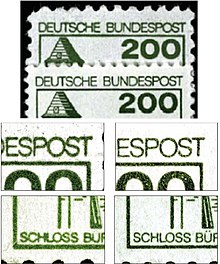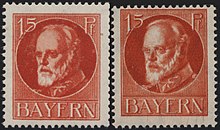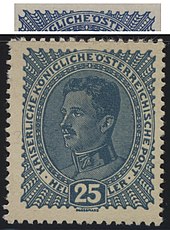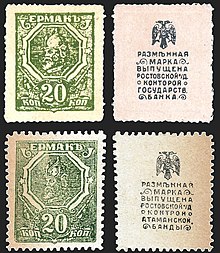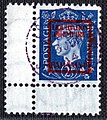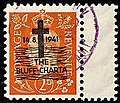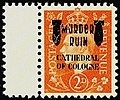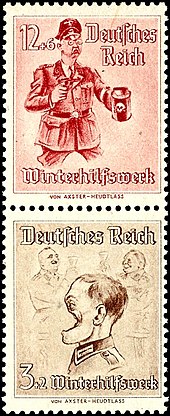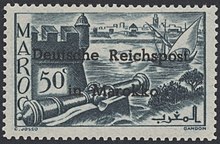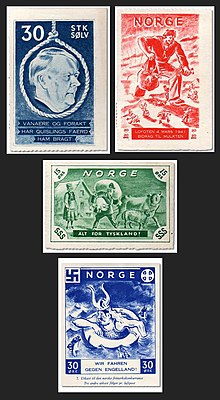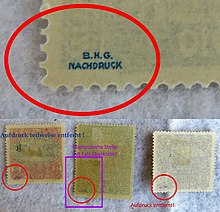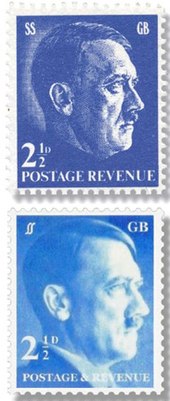Forgery of postage
Under Stamp fraud refers to the imitation of stamps with fraudulent intent, for example, those as real to use or sell. The counterfeiting of postage stamps is legally prohibited.
There are three types of postage forgeries:
- Counterfeiting to the detriment of the post office
- Counterfeit espionage and propaganda
- Counterfeits to the detriment of collectors
Counterfeiting to the detriment of the post office
Counterfeiting to the detriment of the Post is understood to mean the imitation and production of postage stamps by private individuals. The counterfeits are used to avoid postage for postal items .
Shortly after the introduction of the first postage stamp on May 1, 1840 in Great Britain , the first total forgeries of postage stamps appeared. Since the postage was comparatively high at the time and the importance of letters was also greater than it is today, forging postage stamps that were valid for post turned out to be very lucrative.
In addition to total forgeries of postage stamps, there are also partial forgeries, for example the color change by chemical means and the manipulation of the value digits in order to imitate stamps with a higher nominal value. The use of used postage stamps was still very popular . To do this, an (apparently) unused postage stamp was put together from two (or more) used pieces. Occasional attempts were made to remove the pen or the postmark using chemical agents. In addition, postage stamps with only a small part could be partially covered with an original stamp and thus both could be used together.
In 1970 there was a bizarre case of forgery to the detriment of the post office. At this time the German Federal Post Office issued a stamp (Michel no. 657), which addressed the 150th birthday of Friedrich Engels . A group of people close to the DKP then had the idea of designing a “special stamp” for Lenin's 100th birthday (April 22, 1970) and having it printed on their own. For this idea the banknote counterfeiter Horst Baerenz was won over, who produced the final artwork. The stamp was then printed by the DKP printing company in Frankfurt am Main . Some letters were franked with this complete forgery, which were also transported without any problems. However, the forgers were quickly identified and sentenced to a fine of DM 12,000 in court proceedings.
In the late 1970s, forgeries of the 2 DM stamp of the permanent series Burgen und Schlösser (Michel No. 920) appeared, which were relatively easy to recognize by the unclean printing and the rough line perforation .
Today, counterfeiting current, valid postage stamps is no longer particularly profitable: Since the post office has a monopoly on sales, a forger can hardly sell a large number of counterfeits without attracting attention. For your own needs, however, forging is hardly worthwhile; in addition, it is hardly possible any more due to security features in the case of paper and printing ink.
Nevertheless, large quantities of newer self-adhesive postage stamps, which usually come from Asia, are currently being counterfeited. In order to ensure that the counterfeits are sold inconspicuously, the packaging in which the roll brands are located is also forged at the same time. The automatic security systems at Deutsche Post do not always succeed in recognizing and sorting out these forgeries, so that letters with incorrect postage can certainly be transported.
Famous mail forgeries
Post forgeries, especially from the 19th century, are very popular with stamp collectors. They are usually much more valuable than the original brand. The most famous postal forgeries include:
- In Germany :
- In Austria :
- Veronese mail forgery
- Mail forgery in Milan
- Andritzer mail forgery (postage stamps)
- Rovereto Post Forgery (Newspaper Postmark Stamps )
- Szigethvar provisional (postal stationery perforation )
- One of the better-known forgeries is the postage stamp, which for some time was regarded as the world's oldest, which was on a letter from the Carinthian postmaster Ferdinand Egarter to his daughter. While the letter of February 20, 1839 from Spittal an der Drau is classified as genuine, the 1 Kreuzer lift stamp used turned out to be forged. For their preparation have been organic colors used; but at that time only inorganic pigments were used for coloring.
Measures against counterfeit mail
The postal administrations took precautions against counterfeiting of postage early on . These are similar to the protective measures against counterfeit money . The protective measures of the postal administrations have been continuously developed. The most important measures against counterfeit mail include:
War mail and propaganda forgeries
War mail and propaganda forgeries are forged stamps by warring states to harm the enemy .
Counterfeit war mails are imitations of the opposing postage stamps that are as accurate as possible and are used, among other things, to have propaganda material delivered through middlemen through the enemy post. Buying stamps in large quantities through the middlemen would have been immediately noticed by the enemy, especially during a war.
Propaganda forgeries, on the other hand, are forgeries of opposing postage stamps, the image or text of which is propagandistically altered or alienated, for example the lettering German Reich was changed to Futsches Reich .
First World War
British counterfeits for Germany
During the First World War , Great Britain forged German postage stamps. Virtually all postage forgeries are counterfeit spies.
The values of 5, 10 and 15 Pfennig of the Bavarian postage stamp issue with the portrait of Ludwig III. war mail forgeries fell victim to. However, only unused pieces are known. Imperforate proofs of these forgeries were also found. The war forgeries differ in the drawing and in the paper from the original stamps.
The second German postage stamp issue was forged by Great Britain on behalf of the Dutch Propaganda Office. It was used to postage for leaflets and brochures in German. Affected are the postage stamp values of 10 and 15 Pfennig of the Germania edition of the German Empire . The drawing differs from the originals , as does the too thin watermark and the chalk white paper. Unlike the previous war post forgeries, there are also items with real postmarks from both forged stamps.
A type of propaganda forgery that was produced between 1914 and 1918 is also known. In the process, counterfeits of German East Africa stamps were produced that showed the imprint "GEA BRITISH OCCUPATION" and a new value in cents. The five forged editions were about twice the size of the original stamps, presumably in order to be able to show the print in larger font. The brands were apparently intended to relativize the massive German resistance in the colony of German East Africa and to promote an early occupation of the entire area.
On December 12, 1914, two Germania stamps were shown in the French newspaper "Le Matin". A red 10-pfennig stamp was printed with “Switzerland 10 Centimes”, a blue 20-pfennig stamp with “Switzerland 25 Centimes”. The article stated that there are other Germania brands with different values. This was apparently intended to give the impression that neutral Switzerland was about to be occupied by Germany. The German embassy in Bern felt compelled to deny the article and to accuse the newspaper of having fallen for a forgery, which, according to subsequent knowledge, was undoubtedly the case.
British forgeries for Austria-Hungary
Shortly before the end of the First World War, forgeries of 5, 10 and 25 Heller postage from the then current postage stamp issue of Austria ( Hungary had its own stamp issues since the compensation in 1867) were produced in England . The stamps show the Austrian imperial crown and Emperor Karl . The forged postage stamps were printed on slightly yellower paper than the originals. In addition, the brand images of the forgeries are slightly higher (¼ - ½ mm). Used war post forgeries have not yet become known; However, there are mint items of all three values as well as proofs of the 10-Heller value in miniature sheet format in three different colors with the date September 25, 1918.
German counterfeits for Russia
From 1915 to 1917 the Russian government issued eleven different so-called postage stamps. These were printed on thin cardboard instead of regular postage stamp paper. The intention of the Russian government was to use these postage stamps instead of coins in order to save metal. The back of these stamps was ungummed and instead provided with a text that translated something like: “Has the equivalent of silver coins”. Germany forged the 15 and 20 Kopek stamps with an original printing stamp, but changed the text on the back in a propagandistic way. For example, the texts (translated roughly) “Has the equivalent of worthless silver coins” or “Has the equivalent of a bankrupt , fraudulent ruler” were printed on the back .
Russian counterfeits during the Russian Civil War
During the Russian Civil War on December 15, 1917, a "White" Cossack army captured the important city of Rostov- on-Don. The local administration took over the procedure already used by the Russian government to issue postage stamps. The idea of an initially planned 25 kopecks stamp was dropped, but a green stamp worth 20 kopecks was finally printed in July 1918, which showed the image of Jermak , a legendary Cossack leader from the 16th century. The reverse of the stamp was ungummed and showed the text (roughly translated): "Token issued by the branch of the State Bank in Rostov-on-Don". The Russian central government forged this stamp in 1919 and changed the text on the back to (roughly translated): "Token issued by the office of Ataman Gang in Rostov-on-Don".
Interwar period
A mark from the 1920s is known to be a notable forgery of propaganda during the interwar period . An Austrian 80 Heller stamp from 1920 was given a different text. The name “German Austria” was made into “Jewish Austria”. The brand, which clearly depicts anti-Semitic propaganda, was made in a slightly darker red than the original brand. The stamp is known in both the perforated and imperforate versions. As a rule, envelopes with forgeries stuck on were sent together with real brands. The postmark often shows the origin of Vienna . The originator of this forgery is unknown.
Second World War
German counterfeits for Great Britain
From the summer of 1944, the German Reich also made the first counterfeit stamps during the Bernhard campaign . These are exclusively UK propaganda stamps. They were produced in the German concentration camp Oranienburg-Sachsenhausen under the direction of the security police. The stamps were printed on unneeded paper originally made for grocery cards . They were commissioned by Heinrich Himmler .
The first German falsification of propaganda is a falsification of the motif of the 1 ⁄ 2 d commemorative stamp on the occasion of the royal silver jubilee in 1935. The head of the British king was replaced by the head of Joseph Stalin . The inscription (in capital letters) was changed to "THIS WAR IS A JEWSH WAR" (incorrect for: This war is a Jewish war). In addition, the hammer and sickle and the Star of David were added to the brand image. The years were replaced by 1939–1944. There are ungummed (manufactured in this way) and stamped pieces. The SS-Hauptsturmführer Bernhard Krüger , who was responsible for the forgery, declared after the war that the mistake in the word “JEWSH” (missing “I”) was discovered immediately after printing. However, since these were only propaganda stamps anyway, stopping production was no longer considered and all stamps (around 1,000,000 copies) were incorrectly reprinted.
The second German propaganda forgery also concerned a British special stamp and is very similar to its predecessor. The special stamp was originally issued on the occasion of the royal coronation in 1937 and had a face value of 1 1 ⁄ 2 d. In this case, the head of the British Queen was replaced by the head of Joseph Stalin. (The king remained in the background of the stamp image.) The Star of David and the inscription "SSSR / Britannia / Tehran 28.11.1943" (Conference on the definition of the division of Germany - see Conference of Tehran ). The propaganda forgery also exists without gum and stamped, but also in uncut test prints . SS-Hauptsturmführer Bernhard Krüger commissioned the painter and graphic artist Leo Haas to carry out this forgery .
In contrast to the previous propaganda forgeries, the forgeries of the British definitive stamp series from 1937 with the portrait of King George VI. indistinguishable from the originals at first glance. This is also the reason why these fake propaganda with real postmarks from the UK Post exist. Only small elements of the drawing were changed. The penny sign was cleverly replaced by a hammer and sickle, the crosses of the crown were replaced by stars of David, as well as individual elements of the thistle at the top left. In the middle of the rose in the right corner there is also a Star of David. A total of six values in the series were falsified in this way. All appear ungummed and (real) stamped. A total of 32 different propaganda prints are known in this series . They are grouped into five different groups.
Two selected series to gain an insight:
- Bomb series (between two aerial bombs there are the words Murder / Ruin (murder / destruction), there are six different variants of the text below)
- Cathedral of Rouen ( Rouen Cathedral ) - one of the most beautiful and famous churches of France in the Gothic style; was badly hit by Allied aerial bombs
- Castelle Candolfo ( Castel Gandolfo )
- Monte Cassino ( Monte Cassino ) - historical monastery , completely destroyed by the Allies on February 15, 1944, as German soldiers were suspected there, but they were forbidden to enter the historical building (compare Battle of Monte Cassino )
- Schaffhausen (Switzerland) ( Schaffhausen ( Schweiz )) - city in neutral Switzerland, which was bombed by the Allies in 1944, the causes are still unclear
- San Marino ( San Marino ) - Despite the neutrality of the state and the marking of the state territory with huge white crosses, British bombers dropped several hundred bombs on San Marino on June 26, 1944
- Cathedral of Cologne ( Kölner Dom ) - badly damaged by Allied bombs
- Invasion series (different sentences and common initials AAAO)
- But who will return? - But who is coming back?
- An order of Stalin - An order from Stalin
- England bleeds on the order of Moscow - England bleeds on Moscow's orders
- England has lost the war. England lost the war
- A military adventure
Strangely enough, there are also forgeries from these series to the detriment of the collectors: So the various overprints on original stamps of the British postal stamp series (Michel no. 198-203) are forged. Easily recognizable by the unchanged symbols, the missing wave watermark and an imprint using the “flat printing process”.
The propaganda forgeries were not limited to postage stamps. The associated special stamps and commemorative sheets were also produced in Russian and English.
Propaganda stamps on postcards
For use within Germany, some postcards were made that already had propaganda stamps printed on them. These were made by Heinz Fehling. The brands were supposed to ridicule Allied leaders like Churchill , Chamberlain or Stalin . The stamps with the likeness of the respective persons bore an indication “Wert nicht pfennig”. There are postcards that have been sent or stamped both with and without additional postage.
American counterfeits for Germany
The US government also recognized the potential of war mail and propaganda forgery during World War II.
Initially, the forging of the two postage stamps of 6 and 12 Reichspfennig of the German Reich was started. Adolf Hitler was depicted on them . They were produced in the fall of 1944 by an OSS US field post printer in occupied Rome . These were used to create confusion in the enemy country. They were stuck on letters, given forged postmarks (Vienna 8, Vienna 40, Hanover 1) and dropped over the south of the German Reich by airplanes in Operation Cornflakes . Such letters with invented sender names , forged stamps and postmarks were found especially in the vicinity of Vienna, which was then the second largest city in the German Empire . The letters contained propaganda material. A whole mailbag with these forged letters was even delivered in Berlin. In addition to the stamped war post forgeries from the letters, there are still mint items today, as not all of them were used up. The counterfeits, however, differ greatly in perforation , paper and gumming from the original postage stamps .
The Americans soon released the first falsified propaganda. The model for this was also the postal stamp series of the German Reich with the portrait of Hitler. For the carmine-red 12 Reichspfennig value, a skeleton similar to a skull was inserted into Hitler's face . The inscription was changed from the German Reich to " Futsches Reich". This falsification of propaganda has not yet become known as a stamp. The stamp pad on the occasion of Adolf Hitler's birthday in 1937 was forged according to a similar principle . On the four stamps of the block, which originally showed Adolf Hitler, you can see Hitler's skull above numerous graves . The values have been replaced by small gallows . The inscription "German Reich 1944" was added in the lower lines. This block was produced by the US Office of Strategic Services (OSS) in 1944 in a brown-purple and a dark green color variant . Only five preserved blocks of the brown-violet variant are known. Of all falsified propaganda, there are in turn fakes to the detriment of collectors.
Propaganda forgeries of field postcards were also produced.
American counterfeits for Japan
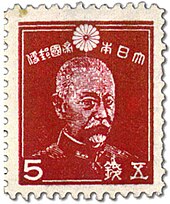
After the war in East Asia even after the collapse of the Nazi regime in Europe continued that attempted Office of Strategic Services (OSS) in Japan by subversive to measures the Japanese antiwar indoctrination . For this purpose, letters and postcards sent to relatives of soldiers in Japan containing defeatist messages were forged . For this purpose, a Japanese 5- sen postage stamp was forged between April and June 1945 in order to be able to postage the same . However, it is questionable whether postcards or letters with such postage could ever be delivered, since - unknown to the US side - the postage in Japan for such mail items had already been increased from 5 Sen to 7 Sen on April 1, 1944. Thus, such frankings were probably not forwarded.
Soviet forgeries for Germany
The Soviet forgeries were limited to forgeries of postcards, the so-called propaganda cards. Numerous different cards were produced, some of which are provided with the imprinted brand image for 6 Reichspfennig of the Hindenburg postal stamp series.
British counterfeits for Germany
As in the First World War, counterfeit war mails were produced in Great Britain for the German Empire during the Second World War. In this war, however, falsified propaganda were also produced.
First of all, forgeries of the 12 Reichspfennig value of the Hindenburg postage stamp series of the German Reich were produced, similar to the practice of the allied US Americans, in order to smuggle propaganda material into Germany. This was also done by aircraft dropping the letters franked with the counterfeit stamps over Germany. This was followed by the values of 3, 4, 6 and 8 Reichspfennig. This war post forgery is also known to be mint never hinged, as not all postage forgeries have been used up.
In addition, forgeries of the subsequent Hitler postage stamp series were made. These were glued to four different cards and given a text. There are no stamped pieces, but there are imperforated proofs. British war mail forgeries of field post approval stamps are also known.
However, it was mainly in Great Britain that falsified propaganda were produced. The first of its kind was based on the German Hitler postage stamp series, in which Adolf Hitler was replaced by Heinrich Himmler. There are two distinctly different variants, one with wide lines, a second type with narrow lines; of the second type there are imperforated proofs both in violet and in black, of the first type in violet. No copies have been found genuinely canceled; all previously known documents are clearly forgeries to the detriment of collectors. However, some postcards and envelopes were made by the British secret service PWE , which were prepared with Himmler stamps and forged German post and censorship stamps. These were intended for neutral states such as Switzerland , Sweden or probably Portugal , so that agents could distribute them there. Some of these mail pieces have been preserved.
The Himmler brand was designed by the British secret service with the intention of driving a wedge between the leadership of the Nazi regime. With the idea that Himmler was planning an overthrow and wanted to make himself a new leader or president of Germany, an allegedly prepared stamp issue with his portrait was considered suitable to bring this idea to the minds of the Nazi leadership in particular. The brand was spread through British agents, particularly in neutral Switzerland . It was hoped that stamp collectors would become aware of this stamp and that a major press campaign would then take place about it. However, it turned out that this forgery did not attract any particular attention in Switzerland or the rest of Europe. Ultimately, the British agents were forced to take the Himmler stamp directly to stamp dealers in order to publicize it. However, even this measure did not lead to the desired success and the action turned out to be a complete failure, since practically no one believed in the alleged Himmler coup. What was strange, however, was that a member of the US secret service OSS in Bern ascribed an extraordinary importance to this brand. On June 10, 1944, US agent Allan Dulles wrote a detailed report for his superior office in Washington , in which he described the puzzling mark. Since the US side had surprisingly not been informed of the forgery by the British secret service, the US secret service started unnecessary research and thus tied up personnel, which ultimately made the entire operation an embarrassing breakdown.
The Jewish concentration camp inmate Adolf Burger , who had taken part in the Bernhard Aktion , described after the war that Heinrich Himmler was very outraged by this British forgery with his portrait. This apparently prompted him to pay back with the same coin and to commission mocking propaganda stamps for the British side.
The next British propaganda forgery took the special stamp of the German Reich from 1943 on the occasion of the 20th anniversary of Hitler's march on the Feldherrnhalle as a template. The portrait of General Witzleben (participated in the assassination attempt on Hitler on July 20, 1944 and was executed on August 8, 1944) was added and the date of the anniversary was replaced by "Hanged on August 8, 1944". This propaganda forgery is also not known to be canceled.
Later two stamps of the German Reich of the special stamp series were forged by Great Britain in favor of the Winterhilfe 1938. Instead of the actual pictures, at the value of 12 + 6 Reichspfennig you saw a caricature of Heinrich Himmler, who collects for winter aid with a box with a skull on it. On the value of 3 + 2 Reichspfennig of the special stamp series, a soldier with a smashed face and in the background Julius Streicher and Hermann Göring could be seen instead of the original drawing. Both stamps were produced together in a stamp booklet measuring 5 × 2. Arch shapes are not known. The stamp booklets were delivered to free Polish units in the Mediterranean from January 1943 and to resistance groups in France from April 1943. Stamped stamps that were already on propaganda letters intended for occupied Poland were also prepared. The action was stopped at short notice and all letters - with the exception of a few received - were destroyed.
The last British forgery of propaganda for the German Reich during the Second World War concerned a special stamp from 1944 on the occasion of the 21st anniversary of Hitler's march on the Feldherrnhalle . The brand image was replaced by an image of Heinrich Himmler, who puts shackles on a civilian. The inscriptions remained unchanged. The propaganda forgery exists only mint and as an imperforate proof.
British counterfeits for areas occupied by Germany
The British falsified propaganda were not limited to the German Reich itself; Propaganda forgeries were also produced for areas occupied by German soldiers.
General Government
The propaganda forgeries for the Generalgouvernement, which was occupied by the Wehrmacht after the attack on Poland and after the division of territory within the framework of the German-Soviet border and friendship treaty on October 26, 1939 and (also) regarded as a foreign country from the perspective of the German Reich (for the occupied Polish Territories) were initiated by the UK Psychological Warfare Office for political reasons.
The model for these forgeries was the Hitler postage stamp series for the Generalgouvernement. (The Generalgouvernement had different postage stamp issues than the German Reich.) At the value of 20 Groszy , the portrait of Adolf Hitler was replaced by the portrait of the Governor General Hans Frank . The rest of the brand image (color, frame, text, value level, etc.) remained unchanged.
The stamps were produced in England in miniature sheets of 20 stamps and dropped from an airplane over occupied Poland. The Polish underground movement was able to smuggle them into the postal service with real postmarks on numerous propaganda documents and on letters containing propaganda documents in the General Government for a few weeks in the summer of 1943. Most of these letters were still confiscated by the German authorities at the post offices. Letters that can be proven to have been sent are therefore very rare. The intended creation of unrest by means of this forgery could only be achieved in the area of the German authorities.
In addition to the stamped items on the letters, there are still imperforated proofs as well as mint never hinged items. For the (rising tendency) catalog rating of this brand, see z. B. Michel catalog Germany special volume 1 under war and propaganda forgeries catalog number 33.
Morocco (not occupied by Germany)
In Morocco , Great Britain circulated counterfeit propaganda that was passed off as a product of the German Empire. For this purpose, postage stamps from French Morocco were provided with the imprint "German Reichspost in Morocco". This should simulate an imminent German occupation. Allegedly the forged brands were sent to the US embassy in Paris , where they were then presented to pro-German head of state Philippe Pétain or Prime Minister Pierre Laval . There are still 11 mint never hinged copies at 50 centimes and 7 mint never hinged copies of the airmail stamp at 1 franc .
Norway
Great Britain also made propaganda stamps for Norway . There were four different variants that were brought into the country in 1941 by agents and aircraft drops. The circulation was a total of 200,000 pieces, presumably 50,000 pieces of each variant. The brands did not resemble any role models and were completely redesigned, as they were actually intended as so-called "gummed labels" (rubberized stickers that should not only be stuck on letters). There is evidence that the first of these propaganda forgeries appeared on June 7, 1941 in Bergen . Brands were later found in Askøy , Osteroya and Fusa Fjord. A stamp in green shows a fat Nazi officer with a pig under his arm, who is apparently destroying a Norwegian woman's livelihood. The label reads u. a. "Alt for Tyskland!", Which translates as "Everything for Germany!" A stamp in blue shows Hitler with a Viking helmet swimming in a lifebuoy and the inscription "We're going against Engelland!" A stamp in red shows a sailor who collects little "Nazis" in a sack. Another stamp in blue shows the NS governor of Norway, Vidkun Quisling , with a rope around his head. The inscription reads "Vanaere og forakt har Quisling's faerd ham bragt", which translates as "Quisling's behavior brought him contempt and dishonor".
Netherlands
Between April 1941 and November 1941, the British secret service PWE produced war forgeries of the Dutch 1 ½ cent “seagull stamp”, the original of which was from 1935. The forgeries made in England were probably given to paratroopers who jumped over the occupied Netherlands. They were then possibly used to stamp postcards that did not contain more than five words. It would also have been possible to postage the postage on envelopes with inserted propaganda material. The stamps were produced in sheets of 20 pieces each in the format 5 × 4 and were of rather poor quality.
Jersey (Channel Islands)
The propaganda forgeries of two brands on the Channel Island of Jersey can be viewed as curiosities . Jersey, like the rest of the Channel Islands, was occupied by the German Wehrmacht from 1940 to 1945. The British designer and engraver NVL Rybot was commissioned by the German administration to design and print Jersey stamps. Apparently to his personal satisfaction, he engraved the very small and inconspicuous letters “AABB” and “AAAA” in the four corners of the ½ and 1 pence stamps. After the war, Rybot declared that he inserted the secret letters to strengthen the fighting spirit of the British, who had been informed about the forgery. According to him, the letters "AABB" should be an abbreviation for the words "Adolphe Atrox" and "Bloody Benito", Latin for "Cruel Adolf" and English for "Bloody Benito". In contrast, the letters "AAAA" would have had the abbreviated meaning "Ad Avernum, Adolphe Atrox", Latin for "To hell, cruel Adolf".
Bohemia and Moravia (Czechoslovakia)
A very rare war forgery of a Czechoslovak 5 Koruna tax stamp from 1938 is known, which was presumably produced at the beginning of the war by a group in exile from Germany-occupied Czechoslovakia based in London. According to post-war records, it was supposed to be used to equip paratroopers with forged passports, which are then dropped over occupied Czechoslovakia. The way in which the stamps were made was very unusual. They were printed in blocks of four on very transparent paper, with all stamps separated by wide bars. In addition, 2 stamps were printed on the front of the paper, 2 stamps above on the back of the sheet. Since only one known sheet of stamps has survived, it is assumed that it is a test print. An expansion of production was apparently not considered afterwards.
British forgeries for Italy, an ally of Germany
Propaganda forgeries were also produced for Italy , which was allied with Germany in World War II . So the design of Michel No. 625 (Italy) was changed by distorting the heads of Hitler and Mussolini in a caricature manner, so that the impression arose of contrasting an "aggressive and grim" looking Hitler with a "perplexed and intimidated" looking Mussolini . The Italian text has been changed from (translated) “Two peoples, one war” to “Two peoples, one leader”, with the word Führer written in German. Also in the right “Italian part” the cutting and stabbing weapons were depicted heavily worn or damaged. In the left "German area" the sword hilt was given a small caricature of a head or face. The characterization of the German dominance over Italy in the propaganda forgery Michel No. 626 (Italy), 50 Centesimi was more subtle . The stamp issued in the original in a shade of purple was printed in green. The text was changed from "Poste Italiane" to "Two peoples / One war". Both forgeries were believed to have been made in autumn 1943. The British Political Warfare Executive (PWE) also produced two propaganda booklets in Italian on which the Italian brands are depicted. Michel No. 626 (Italy) can be seen on one of the booklets, but in blue instead of purple. As early as early 1943, the PWE probably produced a war forgery of the Italian postage stamp with the image of King Victor Emanuel III . It is assumed that this was to be used for franking the propaganda booklet "Neapolitan Letters" from 1943. There are both perforated and imperforated pieces of this brand. The forgery differed mainly in the perforation (14 ¾: 14) from the original (14).
British counterfeits for the Vichy government (France) collaborating with Germany
A fake propaganda was also produced for the government in France ( Vichy regime ) collaborating with Germany . For example, the brand Michel No. 513 (France) was changed so that, in addition to the pro-German head of state Pétain, a “demonic” looking Prime Minister Laval appears in the background. Mainly, however, war forgeries were produced in 1942, which were supposed to be used for franking propaganda letters. In total, there were four forged motifs with eleven different values. The so-called Merkur and Iris stamps as well as the issues of the head of state Pétain with and without headgear were forged. With the forged stamps, around 1000 letters per week were smuggled into the French postal system. These contained propaganda material with titles such as “La France Libre” or “Weekly Times”. In the same year 1942, the production of the counterfeit stamps was stopped again, because the British Political Warfare Executive (PWE) ended the propaganda letter campaign. A forgery of a red-brown 1.50 Franc stamp "Pétain without headgear" made in early 1944 came from a French underground movement and was allegedly used from January 25, 1944 to May 30, 1944 to send conspiratorial literature.
Cold War
From West Berlin for the GDR
In West Berlin, counterfeits were produced by the Combat Group against Inhumanity (KgU) to damage the post . All forgeries were used and therefore exist in both mint and postmarked form.
During the postage stamp issue of the GDR with the picture of Wilhelm Pieck and values of 12 and 24 Pfennig, a (gallows) rope was placed around his neck and the country's name was changed to "Un-German undemocratic dictatorship".
Forgeries were published for six values in the GDR's five-year plan series of postage stamps . At the value of 12 Pfennig, the name of the country was replaced in 1952 by the request “Work slowly in the non-German undemocratic republic”. The unchanged brand image shows a farmer, a craftsman and academics. With a value of 21 Pfennig, the country's name was changed to "Undermanaged Undemocratic Republic". The brand image with Stalinallee was given the new caption “Berlin Stalinallee / Strasse des 17. Juni ”. Since the original stamp of the value of 24 Pfennig of the five-year plan series in 1953 received a new value indication by means of an overprint, such a stamp was also printed on the forgery. The forgery exists with and without imprint. In 1954 the next fakes in this series were made. The forged value of 6 pfennigs this time kept the name of the country unchanged, but the symbol for the five-year plan, which was in the lower right corner of every stamp of this series, was replaced by the symbol for free elections (oath hand with "W") replaced. The brand image, which shows two workers shaking hands, has changed a lot. One worker gives Walter Ulbricht a piece of paper on the forgery that says “Free elections” and sends it to Moscow . When the value of 24 Pfennig was falsified again, the caption was changed to “Berlin - Strasse des 17. Juni ” and the symbol for free elections was added. The last forgery in the five-year plan series was worth 20 pfennigs with a picture of the Bad Elster spa house . The caption has been changed to "Elster - Bad der Werkbonzen". The KgU also produced official stamps for the GDR war mail. At the end of 1954, the KgU stopped producing stamps.
A little later, more forgeries were made by Willi-Peter Kleine, who lived in Berlin-Steglitz . He added the text "We want to be free as the fathers were" on a Schiller commemorative stamp. He made the “day of human rights” a “day of people without rights”. On the 20 pfennig stamp for the 500th anniversary of the University of Greifswald , he finally smuggled a Red Army soldier with an MP and knout into the university coat of arms . Willi-Peter Kleine forged both complete stamps and parts of a brand by adding different imprints to them. These were either attached to the front of the brand or hidden on the back. This procedure was apparently intended to make postal delivery easier and only make the text visible when the stamp is removed from the letter. Kleine escaped criminal prosecution because the relevant provision in the StGB (Section 275) only forbade the forgery of valid stamps and GDR postage stamps were not regarded as such by the Federal Republic of Germany. Small letters stuck with forgeries were also franked with real stamps in the amount of the prescribed postage.
Counterfeits to the detriment of collectors
Counterfeiting to the detriment of collectors means the forging of stamps with a high collector's value. These are said to be sold to philatelists with fraudulent intent .
There were and are numerous forgers who, thanks to modern technology, are able to copy rarities almost true to the original.
Even post forgeries as well as war and propaganda forgeries were and are in turn counterfeited due to their sometimes high value, to the detriment of the collectors. It is then a counterfeit counterfeit.
Vertigo issues
It happens again and again that postage stamps are invented by countries that do not exist. One speaks of so-called fraudulent expenditure. A well-known example are the stamps of the Republic of Maluku Selatan , forged by the stamp dealer Henry Stolow (see: Postal History and Stamps by Maluku Selatan ).
Partial forgeries
Partial forgeries are the falsification of individual parts of a real postage stamp. The most common partial counterfeits are:
- Change of perforation (perforated → cut)
- Forgery of a watermark
- Falsification of misprints , for example color misprints
- Forged stamps
- Imprint forgeries
- Counterfeits of rare shades of color
- Re-gumming
- Repairs
By z. B. Imprint counterfeit brands, which can be obtained very cheaply without imprint, are usually increased in value by orders of magnitude.
The same applies to brands that have been gummed up. As a result, often unfolded postage stamps or postage stamps that have no gumming, but also no cancellation, are usually considerably increased in value because they are intended to simulate a mint never hinged copy. A well-made re-rubber coating can usually only be recognized by specialists. Simple re-gumming is usually revealed by the fact that the gumming runs right into the tips of the teeth, including the paper fibers.
Falsifying shades of color is only worthwhile in certain cases. Often there are color deviations of a brand within a certain framework, which have no influence on the value determination. These are also not listed as an independent variant in the catalog. Worthwhile forgeries are sometimes carried out through the use of chemical baths that cause a change in the color pigments . In the rather complicated process of determining the correct color value of a brand, the only thing that helps is usually to consult a specialist, as the differences between real / fake or color nuance "a" or "b" are often only marginal.
Reprint forgeries
Often very valuable postage stamps or entire mail items are legally reprinted in order to make them available to a wider audience. In contrast to reprinting , in which a real printing stamp is used, a replica printing stamp is used for reprinting . Postage stamps produced in this way must be marked. So either on the front or back of the stamp imprints with the note “ facsimile ”, “reprint” or “ reproduction ” must be attached. Counterfeiters try to remove these imprints using suitable means in order to simulate an original brand. However, illegal reprints are also produced that lack the identification of a reprint from the outset. Nowadays, entire sheets of such counterfeit brands often come from Asia. In the case of “better” forgeries, even the test stamp of a well-known inspector is forged and printed on at the same time.
Machinations
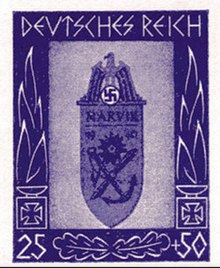
Occasionally, alleged stamps appear that are not listed in the relevant stamp catalogs . These are usually works by private forgers who try to deceive collectors with "previously unknown rarities" and earn money with them. In particular after the Second World War, as far as they were aware of falsified propaganda, private individuals were inspired to produce their own creations and offer them to collectors as alleged falsified propaganda and sell them for profit.
In exceptional cases, however, even works of art can be highly traded in collectors' circles. Fantastic brands from 1978 that were made in Great Britain represent an exceptional case. That year, British author Len Deighton published a book called SS-GB . The story is about a Great Britain that was occupied by Nazi Germany during World War II. In connection with this, a stamp with Hitler's head and the inscription "Postage Revenue" appeared on the cover of the book, as can be found on all British stamps. As a clever marketing strategy of the publisher, a booklet of stamps appeared to introduce the book, which contained the alleged Hitler stamps with three different values and three different colors of six each. The British Post, however, was not at all impressed by this and as quickly as possible confiscated any stamp booklet it could come into possession of. The remaining booklets quickly became a rarity in collectors' circles. In England, for example, 300 British pounds were paid for a booklet at auction . In Germany one achieved the proud price of DM 1,250 in 1998 . So it was not long before counterfeiters came up with the idea of counterfeiting even these booklets with fantasy stamps. These forgeries also brought in several hundred dollars on the US market .
Occasionally appear concoctions, called Rubberized stickers (Gummed labels) have been modeled. These stickers were the work of US and British propaganda institutions that had been brought into hostile areas. There they should z. B. be glued to tables, mirrors, walls, motor vehicles or public buildings in order to have a corrosive effect. Such stickers have seldom been made into postage stamps in order to simulate franking. Some counterfeiters use this procedure as a guide and produce works based on this model.
Stamp inspection
Since collectors prefer tested brands, counterfeiters have also recognized the possibility of forging the test stamps from renowned federal auditors. Even in such cases, only recognized experts who can identify a wrong test stamp can usually help. Often, wrong test stamps reveal themselves by the fact that the letters of the name of the tester are unevenly large, not upright or not in an exactly straight line. The spacing between the individual letters must also be very regular.
Well-known stamp forgers
Some forgers of postage stamps became famous among collectors for the perfection of their forgeries. Your counterfeits are by no means worthless, but a popular addition to collections. The most famous stamp forgers include:
literature
- Fritz Cheap, Otto Stiedl: Large Handbook of Forgeries. F. Cheap, Vienna 1934.
- Ullrich Häger: Large encyclopedia of philately. Bertelsmann, Gütersloh 1973.
- Wolfgang Maassen , in collaboration with Wilhelm van Loo: Real or false? - that is the question! Counterfeiting and Counterfeiting in Philately. Guide for stamp collectors. Volume 3, Verlag Phil Creativ, Schwalmtal 2003, ISBN 3-932198-48-4 .
- Joachim Hosang: Toothed War Propaganda. Manual and catalog.
- M. Williams: Forged Stamps of Two World Wars. London.
Web links
- Website of the Association of Philatelic Auditors
- Association of Philatelic Auditors eV
- Association of Austrian Postage Stamp Checkers
- Free stamp help Combating counterfeiting with free (over) checks of forgeries and other stamps
- Philatelic Experts: examiners worldwide (including old examiners), and their certification marks
- Detection of repairs and forgeries
- Espionage or war and propaganda forgeries worldwide with description for detection
- GDR propaganda forgeries
Individual evidence
- ^ Lenin to the detriment of the Federal Post Office
- ↑ Fake "Vogelwarte Helgoland" , on jolschimke.de
- ↑ The upside-down Szigetvár temporary arrangement and its companions ( Memento from June 4, 2015 in the Internet Archive )
- ↑ Beyars.com: The great art dictionary by PW Hartmann, keyword “Postage stamp” , queried on March 13, 2009
- ^ British Forgeries of the Stamps and Banknotes of the Central Powers. Retrieved May 5, 2019 .
- ↑ PsyWar.Org - Propaganda & Espionage Philately - Part I. Retrieved on May 4, 2019 (British English).
- ^ Propaganda and Espionage Philately By SGM Herbert A. Friedman (Ret.) , On psywar.org
- ↑ PsyWar.Org - Propaganda & Espionage Philately - Part I. Retrieved on May 7, 2019 (British English).
- ↑ PsyWar.Org - Propaganda & Espionage Philately - Part I. Retrieved on May 6, 2019 (British English).
- ↑ PSYOP Mistakes. Retrieved April 28, 2019 .
- ↑ Peter Edel : When it comes to life. Autobiography, 1st edition, part 2, Verlag der Nation, Berlin 1979, ISBN 3-87682-714-0 , p. 54 ff.
- ↑ Wolf H. Wagner: Escaped from hell. Stations of a life. A biography of the painter and graphic artist Leo Haas. Henschel Verlag, Berlin, 1987, ISBN 3-362-00147-5 .
- ^ A b c d Propaganda and Espionage Philately , on psywar.org
- ↑ THE AMERICAN OSS FORGED POSTAGE STAMP TO FIGHT THE JAPANESE , on psywarrior.com
- ↑ PsyWar.Org - Propaganda & Espionage Philately - Part I. Retrieved April 28, 2019 (British English).
- ↑ PSYOP Mistakes. Retrieved April 26, 2019 .
- ↑ PsyWar.Org - Propaganda & Espionage Philately - Part I. Retrieved April 28, 2019 (British English).
- ↑ PsyWar.Org - Propaganda & Espionage Philately - Part I. Retrieved April 28, 2019 (British English).
- ↑ https://www.psywar.org/content/stamps
- ↑ PsyWar.Org - Propaganda & Espionage Philately - Part I. Retrieved on May 14, 2019 (British English).
- ↑ https://www.psywar.org/content/stamps
- ↑ PsyWar.Org - Propaganda & Espionage Philately - Part I. Retrieved on May 4, 2019 (British English).
- ↑ PsyWar.Org - Propaganda & Espionage Philately - Part I. Retrieved on May 11, 2019 (British English).
- ↑ The Resistance Philately. In: Der Spiegel from February 6, 1957.
- ^ Postage stamp forgeries from reprints of valuable postage stamps - How counterfeiters cheat collectors - Film and pictures by Thomas Schmidtkonz , on sammler.com
- ^ Theresienstadt - Wrong! , on stampsx.com
- ↑ PROPAGANDA GUMMED LABELS OF WWII , on psywarrior.com
- ↑ Gallery »Arge Danzig, circular 225 - 4th quarter 2009» Danzig, forged inspection stamp “Dr. Oechsner BPP ” , on danzig.org
